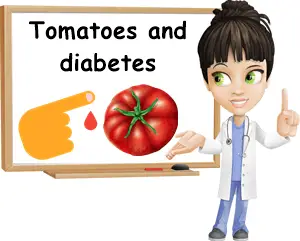You can definitely eat tomatoes with diabetes, whether type 2 or type 1, and do so safely because the botanical fruit and culinary vegetable is low-glycemic, low in carbs and sugar, with minimal effects on blood sugar.
Irrespective of variety, tomatoes aren’t likely to affect blood sugar very much so long as they are eaten in moderation, according to the diabetic patient’s nutritional requirements, level of physical activity and individual response to the food based on degree of glucose tolerance.
Tomatoes glycemic index: 15 (low)
As a diabetic, one of the first things you should know about tomatoes, and pretty much all the food you plan on eating, is what is their glycemic index score.
The glycemic index (GI for short) is a scale that measures how fast the carbohydrates in a food raise blood sugar levels.
Because that’s what carbohydrates do, that is, digestible carbs from food get broken down into their simplest constituents, which are simple sugars, which then get absorbed in the blood like all nutrients from food and raise blood sugar levels.

Glycemic index scale
Foods with a GI score between 0 and 55 are low glycemic. Foods with a GI score between 56 and 69 are moderate glycemic. Foods with a GI score between 70 and 100 are high glycemic. Diabetics and anyone needing to either lower or simply better control their blood sugar are better off choosing foods with as low a GI score as possible, and eat these types of foods as often as possible while avoiding high GI foods to the best of their efforts.
Tomatoes GI and effects on blood sugar
The glycemic index of tomatoes is 15 which is a low to very low score. In part, this is a result of the very high water content of the fruit (over 95% water) which leaves very little actual nutrition, carbs to be more exact, to fuel a rise in blood sugar.
What this means is that eating tomatoes with diabetes does not raise blood sugar levels too much as in too high, or too fast, but rather produces a modest, steady rise and actually helps with better blood sugar control.
Provided intake is reasonable, of course, so don’t go filling up on tomatoes just because they are technically ok to eat with diabetes and high blood sugar. Anything above a normal food intake cancels out the benefits.
Do know that the glycemic index score of tomatoes is a general value that applies to all varieties of tomato whether they’re cherry, Roma or Italian plum, grape or pear, red, green, yellow, orange, purple or black.
Of course, different varieties come with differences in nutritional makeup which engenders small variations in the GI score and subsequently also glycemic effects. So while it’s not untrue to say that all tomato varieties are low-glycemic, factually, they don’t all have the exact same GI score.
When it comes to eating with and for diabetes, one of the most important things is to eat reasonable amounts of food, more exactly, only have small portions. This will help you avoid dietary excesses that could make carbs accumulate and blood sugar go up fast as a result.
The smaller the portion of a food, plant-based in this case, the less carbohydrates you get and the lesser the effects on blood sugar. So with smaller portions comes a reduced glycemic impact which is something to aim for if you have diabetes. Even if a food is already low-glycemic, like tomatoes which have a GI score of only 15, eating small amounts at once is advised.

How many carbs and how much sugar are in a tomato?
The content of carbs and sugar in tomatoes ranges slightly depending on the variety, but even so it’s generally quite low. Roma or plum tomatoes weigh about 62 grams per fruit and have 2.41 grams of carbohydrates of which 1.63 grams are sugars. A cherry tomato on the other hand weighs only 17 grams and has 0.66 grams of carbohydrates of which 0.45 grams are sugars.
A cup of the cherry variety at 149 grams a cup provides 5.8 grams of carbohydrates of which 3.92 grams are sugars. A large tomato variety can easily reach 182 grams and provide 7.08 grams of carbohydrates of which 4.79 grams sugars. A medium fruit at about 123 grams provides 4.78 grams of carbohydrates and 3.23 grams of sugar.
Should diabetics eat tomatoes with their condition?
All in all diabetics can and should eat tomatoes as part of their regular diet. The botanical fruit provides overall modest amounts of carbohydrates and sugar which essential means it cannot fuel a significant rise in blood sugar.
Not to mention the fact that tomatoes are low-glycemic meaning they should have minimal effects on blood sugar given a reasonable intake. Even more, the low-glycemic score is maintained across all varieties meaning whatever kind of tomato you like to eat, it’s likely low-glycemic too.
Of course, not everyone reacts the same way to the same food, or to the same amount of a food. With diabetes it may be because of varying glucose tolerance levels, the way you pair your foods, portion size, frequency with which you eat a certain food or an accumulation of different factors. This is why it may help to know that there are things you can do to further reduce the effects of a food on blood sugar.
- Eat your tomatoes with skin and seeds
That’s where a lot of the fiber is and fiber helps control blood sugar by slowing down digestion and the absorption of sugar into the bloodstream.
- Start off with small servings
Consider portions of the likes of one medium fruit or half a cup of cherry or grape tomatoes and see how you react. Based on your response, modify your intake to suit your individual response, and nutritional requirements of course.
- Start with one serving a day
To assess how a food affects your blood sugar metabolism, introduce it slowly into your diet and monitor your response. You can start with just one serving of tomatoes a day, at least until you can determine what amounts are good for you and how the fruit affects your blood sugar metabolism.
- Slightly less ripe fruit may have lesser effects on blood sugar
There should be more complex carbohydrates and fiber in underripe or less ripe tomato fruit. These take longer to digest because they are harder to break down and thus the glycemic effects are limited even further.
- Eat tomatoes raw
Cooking renders a food more readily digestible which increases its glycemic score and glycemic impact. Having tomatoes raw, preferably whole (pulp/flesh, skin and seeds) is advised.
- Pair with light protein
Nuts, seeds, eggs, cheese, chicken or fish are good choices to reduce tomatoes impact on blood sugar. The fat in animal foods or plant foods such as nuts and seeds further helps with the absorption of the antioxidant lycopene in red tomato varieties which is a source of benefits for eyesight and the cardiovascular system, two aspects of health negatively impacted by diabetes.
- Pair tomatoes wisely
Avoid having tomatoes or fruits in general on an empty stomach or separate from other foods or with other fruits. See tomatoes for what they are, which is a fruit, and pair with sources of complex carbs (leafy greens, legumes even), sources of healthy fat (fish, nuts, seeds, eggs) and especially lean protein (fish, poultry meat).
- Exercise afterwards
Exercising helps not only improve glucose tolerance and lower blood sugar, but also uses up any excess calories that could contribute towards weight gain which is a risk factor for complications in diabetes.
What are the benefits of tomatoes for diabetes?
There is more to tomatoes and diabetes than just a low glycemic index score. Actually, regular consumption of the fruit holds several benefits for both diabetes and general health. But the biggest benefits of tomatoes for diabetes specifically include:
A low glycemic index score (15)
The low GI score of tomatoes translates into reduced effects on blood sugar. Tomatoes also have a low glycemic load score (1) per servings of 100 grams, 200 grams, 1 cup of the cherry variety (149 grams a cup), and 1 large fruit-serving (182 grams).
Good source of potassium for lowering blood pressure
High blood pressure is a common complication in diabetes and getting enough potassium in the diet, or from dietary supplements, is essential for keeping blood pressure numbers within a healthy range.
How much potassium in tomatoes?
You get about 5% of your daily recommended intake of potassium from 100 grams of regular red, ripe tomatoes (237 milligrams). One large whole fruit with skin, pulp and seeds at 182 grams gets you 431 milligrams of the mineral, one Italian plum (Roma) variety at 62 grams gets you 147 milligrams while 1 cup of the cherry variety at 149 grams a cup gets you 353 milligrams.
Other benefits for the cardiovascular system
Cardiovascular health is an important aspect of diabetic health as the cardiovascular system is heavily affected in diabetes. Studies show consumption of tomatoes provides the antioxidant lycopene as well as other antioxidant constituents which help reduce blood lipid oxidation, lower LDL (bad) cholesterol and exert anti-inflammatory effects at the level of the cardiovascular system. Regular consumption actively contributes to better overall cardiovascular health.
Good for weight control and weight loss
Tomatoes are not just low, but very low in calories. How many calories in tomatoes? There are only 18 kcal (kilocalories or calories) per 100 grams of raw, ripe tomatoes, 27 kcal per cup of the cherry variety, 11 kcal per one Italian plum/Roma tomato and 33 kcal in one large fruit at 182 grams. Overall, the energy intake from tomatoes is so low that eating the botanical fruit regularly helps with weight control and possibly also weight loss.
Furthermore, tomatoes are a modest source of fiber, low-carb, low-sugar, low-fat and very high in water, further providing benefits for weight management, a big aspect of diabetic health. Their natural makeup strongly recommends them for a weight loss diet.
Modest vitamin C content for wound healing
Tissue damage is brought on by consistently and abnormally high levels of sugar in the blood, and results in poor wound healing and increased risks of infection which are major concerns in diabetes. Vitamin C has scientifically recognized antibacterial, antifungal and antiviral properties, is proven to lower inflammation levels in the body and modulate the immune system response, being actively involved in advancing healing at a fast rate.
Not just this, but one of the main functions of vitamin C is to trigger the production of collagen, a vital protein that provides structure to most tissues in the body from the skin to tendons and cartilage to teeth and bones. Collagen is directly involved in repairing damaged tissue throughout the body. A healthy intake of vitamin C is essential for proper and fast wound healing, more so in diabetics.
How much vitamin C in tomatoes?
There are 13.7 milligrams of vitamin C per 100 grams of raw tomato, 20.4 milligrams of vitamin C in one cup of cherry tomatoes at 149 grams a cup, 8.5 milligrams in one Italian plum/Roma at 62 grams and 24.9 milligrams of the vitamin in one large fruit with an estimated weight of 182 grams.
